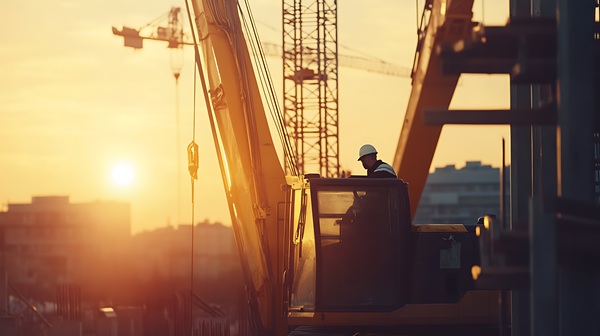New Report Warns of Heat Risk for Crane Operators Nationwide

Heat exposure remains a deadly and costly issue for U.S. workers. In 2023 alone, 55 workers across all industries died from heat-related causes, according to the U.S. Bureau of Labor Statistics. In 2021 and 2022, nearly 5,000 people suffered heat-related injuries or illnesses serious enough to keep them off the job for days, often collecting workers' compensation benefits while they recover.
To help address this growing threat, the National Safety Council, in partnership with the NCCCO Foundation, has released a new resource titled "Addressing Heat Stress in the Crane Industry." The guide provides practical, industry-specific steps to ensure crane workers' safety in high-heat environments.
What is heat exposure and why is it dangerous for workers?
Heat exposure occurs when the body absorbs more heat than it can safely dissipate, typically from high temperatures, direct sunlight, hot work environments, or strenuous physical activity. For construction workers, this can quickly become dangerous because it disrupts the body’s ability to regulate its internal temperature.
When the body overheats, several things can happen, including:
- Heat cramps: These are painful muscle spasms caused by fluid and electrolyte loss.
- Heat exhaustion: Symptoms of heat exhaustion include heavy sweating, weakness, dizziness, nausea, and headache.
- Heat stroke: This is a life-threatening condition where body temperature rises above 104°F, potentially causing confusion, seizures, organ failure, or death.
Work environments can exacerbate the hazards of heat exposure. Heavy protective gear, enclosed spaces with poor airflow, and long hours without breaks all increase the risk. Without proper hydration, rest, and cooling measures, a worker’s condition can deteriorate rapidly.
Unique dangers for crane workers
A 2023 survey by Work to Zero and the NCCCO Foundation gathered feedback from more than 2,000 crane workers. Roughly 75% said they were “likely” or “very likely” to experience heat stress or illness on the job.
Heat stress was ranked as the top contributing factor to personal injuries (18%) and to injuries suffered by others on site (16%).
T.J. Cantwell, executive director of the NCCCO Foundation, stressed the importance of this work.
“This report on heat stress and the accompanying webinar provide employers and employees with important steps they can take to protect themselves from dangerous heat-related injuries, especially during the middle of the summer with heat advisories occurring regularly throughout the U.S.,” Cantwell said.
What are the key recommendations for preventing heat stress on the job?
The report, published through the NSC’s Work to Zero initiative, outlines four core strategies to protect crane workers from heat hazards. These include:
Comprehensive approach
Combine onsite prevention measures, environmental monitoring, and clear heat safety policies. This means integrating heat safety into every level of operations, from daily job briefings to company-wide safety protocols, so that prevention becomes an integral part of the workplace culture.
Work practice adjustments
Use structured work/rest cycles, cooling stations, and acclimatization schedules to reduce risk. Even small adjustments to shift timing, job rotation, or shaded rest areas can significantly lower the chances of heat illness.
Worker education
Train employees on hydration, medical factors, and substance use issues that can increase vulnerability. Ongoing training helps workers recognize the early signs of heat stress in themselves and their coworkers, enabling quick intervention before the condition worsens.
Technology integration
Leverage wearable devices and lone worker technologies to provide real-time alerts and hazard monitoring. These tools can track temperature, heart rate, and location, giving both workers and supervisors the data they need to respond to heat-related risks instantly.
What should I do if I suffer a heat-related illness on the job?
If you suffer a heat-related illness on the job in New York, here’s what you should do — swiftly and safely:
- Stop Work and Seek Shade Immediately: Move out of direct heat as soon as symptoms appear. Find a shaded or air-conditioned area and loosen or remove excess clothing to help your body cool down.
- Rehydrate and Begin Cooling: Sip cool water or an electrolyte drink (even if you’re not thirsty) to replenish fluids. Apply damp cloths or ice packs to your neck, armpits, and forehead, and use a fan if possible to promote evaporation-based cooling.
- Get Help and Monitor Your Condition: Call a supervisor or coworker for assistance. If symptoms worsen, call 911, especially if you experience confusion, dizziness, loss of consciousness, or other signs of heatstroke.
Out of work due to a heat-related illness? Our New York workers' comp lawyers can help.
If you’re out of work due to a heat-related illness, you may be facing medical bills, lost wages, and uncertainty about your future. The New York workers' compensation lawyers at Pasternack Tilker Ziegler Walsh Stanton & Romano LLP have been fighting for hard-working New Yorkers for more than 90 years. We’ll guide you through every step of the workers’ comp process, from filing your claim and getting proper medical care to appealing denials and securing the maximum benefits you’re entitled to.
When you schedule your free, no-obligation consultation, we’ll review your case, explain your rights, and map out a strategy to protect your income and your health. We’ve recovered substantial settlements for injured workers across New York, and we’re prepared to put our experience to work for you.
Whether you’re a crane operator, delivery driver, utility worker, or any other employee affected by extreme heat, we’ll fight aggressively to make sure the insurance companies don’t cut corners on your recovery.
We proudly serve clients in New York City, Long Island, Westchester, Rockland, Albany, Buffalo, Rochester, Syracuse, and beyond. Contact us online or call any of our New York law offices to schedule a free consultation.
“Great lawyers who always handle any concerns that may arise w/case.” - K.S., ⭐⭐⭐⭐⭐
